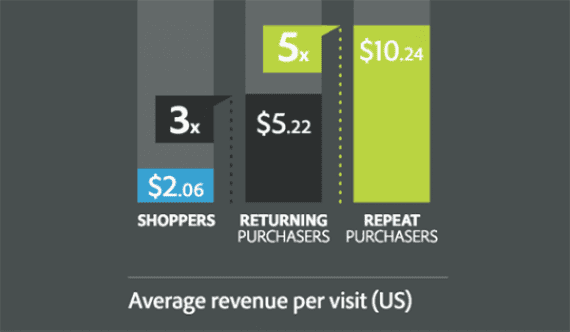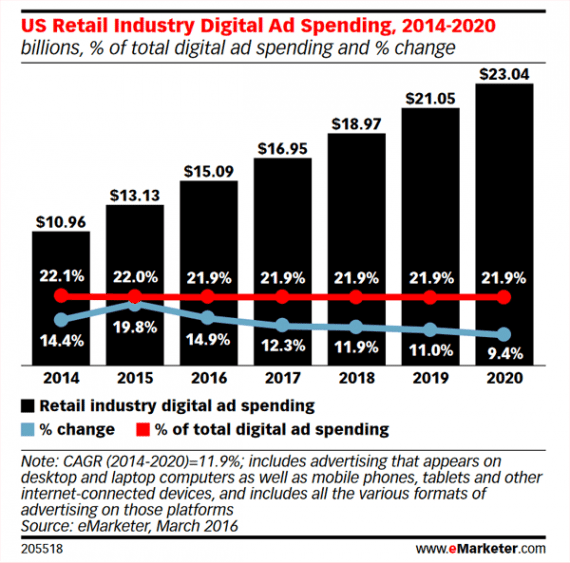
Repeat customers are worth more and they cost less to market to. But many ecommerce marketers focus on getting new customers rather than service the customers they already have. Image: Adobe.
Search engine optimization, paid search advertising, and digital banner advertising are among the most popular forms of ecommerce marketing, but they may not be the most effective for every business. A smart, data-driven plan could help some online retail businesses do better.
By year's end, retail marketers will have spent about $15.9 billion on pay-per-click ads, banner advertising, and other digital promotions, according to eMarketer. In fact, retailers, online and off, are likely to account for 21.9 percent of all U.S. digital advertising spending this year.

Retailers purchase roughly 22 percent of all digital advertising, according to eMarketer.
When retail marketers are not buying digital ads, they are probably worrying about SEO, which is still one of the most popular forms of ecommerce marketing.
Play the ContrarianThere is almost certainly merit to investing in both digital advertising and SEO, but these are not the only ways to grow an ecommerce business. Try playing the contrarian as you consider how your business invests in marketing.
A contrarian is a person who rejects or opposes popular positions. In our context, this implies that you don't like or want to use SEO or digital advertising. So as you plan for the rest of 2016 and beyond, ask yourself how you would improve your business without these.
Here are some suggestions to guide your thoughts.
Quality, Convenience, Value, and Customer Service"The marketing and advertising industries are currently in a state of great confusion," advertising expert and 'Ad Contrarian' Bob Hoffman told a London audience. "In fact we are so confused we have lost touch with reality and also with average consumers — or as I like to call them, people."
"You cannot be taken seriously in any marketing or advertising organization if you suggest that the bulk of consumer behavior is perfectly obvious…asserting that the reason people buy most products is because they are tastier, prettier, cheaper, or are simply more readily available."
Hoffman's point may be that we forget that most of our customers have simple needs. They want a quality product, at a good value, and they want buying it to be easy.
Consider this, earlier this month Unilever, the multinational consumer goods company, agreed to buy online subscription retailer Dollar Shave Club for $1 billion. The five-year-old Dollar Shave Club has grown from no sales to more than $240 million in annual revenue, largely because its razors were cheap and convenient.

Dollar Shave Club used a low price and convenient delivery to grow a billion-dollar business.
While wearing your marketing contrarian hat, ask yourself how you could improve your online store's quality, convenience, value, and customer service. If you improved these areas, how would your business be impacted?
Repeat Customers Are Worth More than New OnesExisting customers are almost always more profitable than new customers. And this has always been the case.
In an often-cited paper from August 2012, Adobe reported that a shopper returning to make a second purchase from an online store will typically spend three times as much as a new customer. And when a consumer returns three or more times to buy from an online shop, that repeat customer will typically spend five times as much as a new customer on each purchase.
In 2014, Marketo cited a Bain & Company study, which found that repeat customers tend to spend 67 percent more than new ones. What's more, "it costs between six and seven times more to acquire a new customer than to retain ones you've already got."
SEO and digital advertising focuses on new customer acquisition. This is good. Every business wants to increase the total number of customers it has. But the ecommerce marketing contrarian knows that existing customers are worth more.
What can your ecommerce organization do to retain loyal shoppers?
Email Marketing Works BestIn February 2015, I wrote "Without Email Marketing, You're Probably Losing Sales." This is still the fact today. Email marketing is probably the single best thing an online retail business can do to drive sales.
Yet, it seems that the majority of ecommerce marketers do not segment, automate, or personalize email-marketing campaigns.
From the marketing contrarian's perspective, how can you invest in other forms of promotion when you have yet to make use of the most powerful tool you have. It is like digging a trench with a spoon whilst your backhoe sits idle.
Content Marketing Will Generate ProfitsConsider, again, Dollar Shave Club. A few paragraphs back I noted the company was recently sold for $1 billion. While Dollar Shave Club certainly participated in many forms of advertising and promotion, it was content marketing that propelled its revenue.
In March 2012, the company posted a one-and-a-half-minute long video on YouTube. The entertaining pseudo-commercial generated more than 12,000 subscription orders in 24 hours.
Not everything your ecommerce store publishes will boost sales the way that this Dollar Shave Club video did, but the opportunity is there.
Ask your inner ecommerce marketing contrarian what sort of content you could produce if you redirected some of your other marketing investments. In the meantime, enjoy these videos.
Advertise Locally for New CustomersDigital advertising and SEO are far reaching. An online store in Boise, Idaho can sell to shoppers 10,000 miles away in Johannesburg, South Africa. But are folks in Johannesburg really the customers that a Boise-based ecommerce business can serve best?

Ecommerce lets you sell anywhere in the world. But are far away customers really the ones you can serve best?
If your warehouse is in Boise, Idaho, you can ship to Idaho residents via ground and expect it to arrive in a day or two. This means you can offer free shipping and compete with services like Amazon Prime.
Also, you likely understand the local market better than your distant competitors.
Last month, I wrote about how online stores could use direct mail to attract new ecommerce customers. As a contrarian ecommerce marketer, consider promoting your products to those customers nearest you. And consider using tactics your competitors might not be.
Measure Everything, Analyze EverythingAs you remove your contrarian hat, remember to measure and analyze everything. Good marketing should be data-driven.
If you generate a lot of sales from direct mail, understand why and repeat the effort. If email helps you retain customers, figure out which emails work best. If banner ads boost your revenue, determine which creative does the best job.
The aim, after all, is constant improvement.
Source: A Brief Guide to Contrarian Ecommerce Marketing
No comments:
Post a Comment